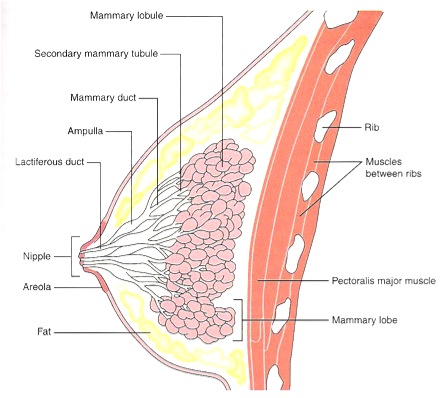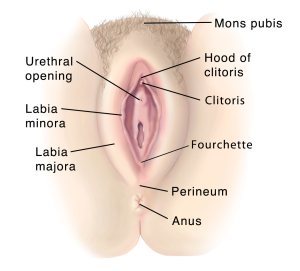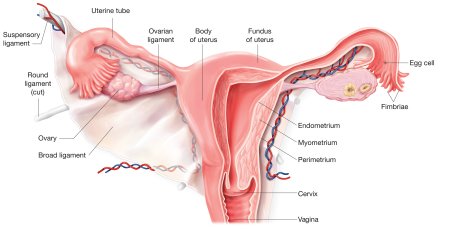The female breasts
- Category: The female reproductive system
- Views: 81391

The breasts are a pair of milk-producing organs of the female reproductive system located on the left and right sides of the anterior thoracic (chest) region. Each breast projects outward from the anterior of the chest as a mass of skin-covered soft tissue. At the tip of the breast is a small cylindrical projection of erectile tissue called the nipple. The nipple is bordered by a ring of thickened, bumpy skin called the areola. Both the nipple and areola are highly pigmented compared to the surrounding skin of the breast, resulting in a darkened appearance.
The vulva
- Category: Urinary system, The female reproductive system
- Views: 155864

The vulva is the collective name for the external female genitalia in the pubic region, including the labia, clitoris, and urethral and vaginal openings. These organs work together to support urination and sexual reproduction.
The exterior of the vulva begins as a mound of skin-covered adipose known as the mons pubis that arises from the skin covering the pubis bone in the pubic region. As it continues inferiorly, the mons pubis divides laterally into the two parallel labia majora. The labia majora are wide folds of skin and adipose that rise beyond the mons pubis and surround the pudendal cleft, a deep vertical furrow in the center of the vulva. Both the mons pubis and labia majora are covered in pubic hair following puberty and serve to protect the delicate structures of the vulva found in the pudendal cleft.
The uterus
- Category: Endocrine system, The female reproductive system
- Views: 188791
The uterus, also commonly known as the womb, is a hollow muscular organ of the female reproductive system that is responsible for the development of the embryo and fetus during pregnancy. An incredibly distensible organ, the uterus can expand during pregnancy from around the size of a closed fist to become large enough to hold a full term baby. It is also an incredibly strong organ, able to contract forcefully to propel a full term baby out of the body during childbirth.
The uterus is approximately the shape and size of a pear and sits in an inverted position within the pelvic cavity of the torso. It is located along the body’s midline posterior to the urinary bladder and anterior to the rectum. The narrow inferior region of the uterus, known as the cervix, connects the uterus to the vagina below it and acts as a sphincter muscle to control the flow of material into and out of the uterus.
The ovaries
- Category: Endocrine system, The female reproductive system
- Views: 166030
The ovaries, a pair of tiny glands in the female pelvic cavity, are the most important organs of the female reproductive system. Their importance is derived from their role in producing both the female sex hormones that control reproduction and the female gametes that are fertilized to form embryos.
Each ovary is a small glandular organ about the shape and size of an almond. The ovaries are located on opposite sides of the uterus in the pelvic cavity and are attached to the uterus by the ovarian ligament. The open ends of the fallopian tubes rest just beyond the lateral surface of the ovaries to transport ova, or egg cells, to the uterus.

